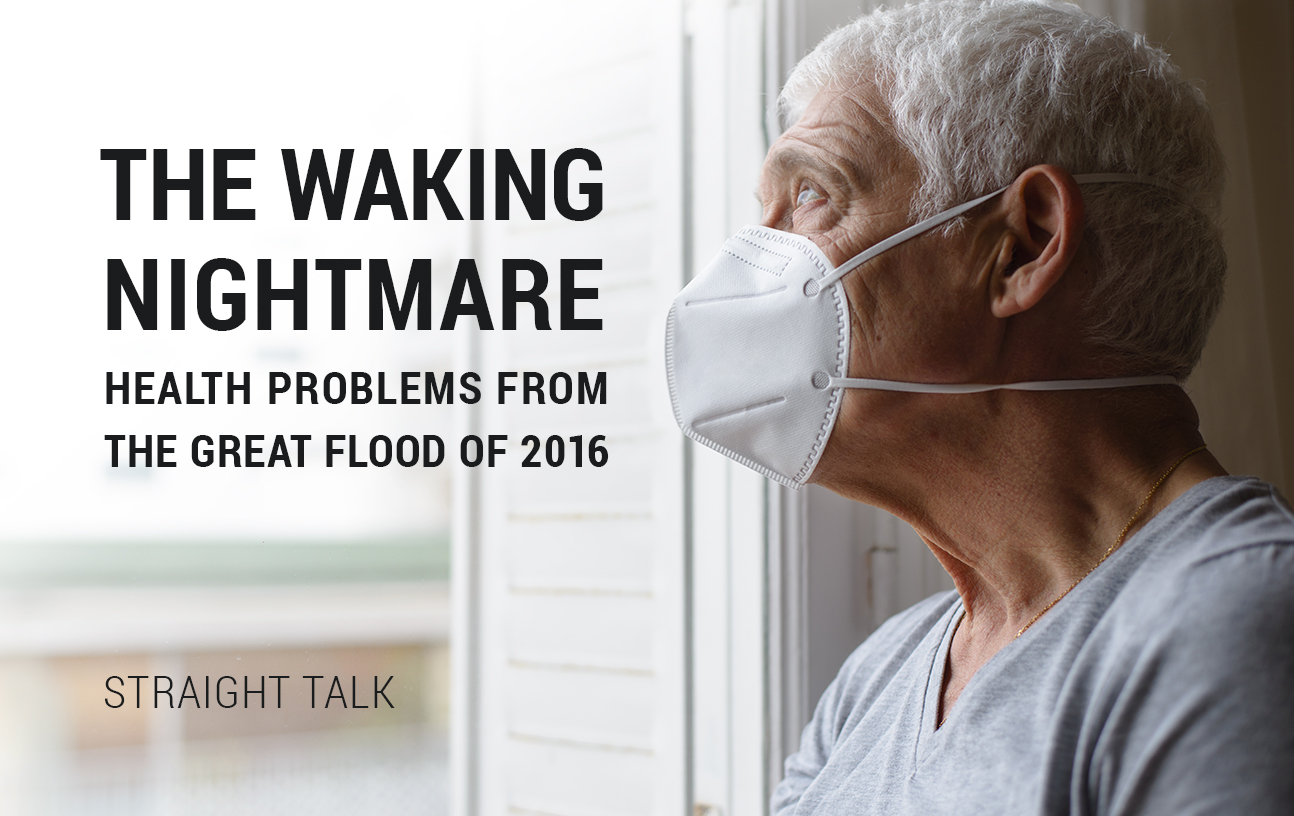I’m having a really bad dream, but I’m wide awake! You know the one I mean? Where you are in an impossible situation, you see something really bad about to happen, and there is nothing you can do about it? And you just have to watch the horrible event unfold, unable to change or alter it? Worst dream ever.
This waking bad dream I’m in right now is a direct product of the Great Flood of 2016. When I saw the extent of August’s flooding, I knew we were in trouble. Lots of areas that flooded were way above any historic flood plain. I knew lots of flooded houses would not be covered by flood insurance. I just KNEW there would be tons of folks forced to move back into homes that had not been properly cleaned for human habitation. For a variety of reasons, including fear, money, security, maybe even because they had nowhere else to go, people were going to come back to their homes, even if they were completely unsafe for human habitation.
This particular nightmare is all too real. Fighting back against it keeps me awake and very busy.
Recently I had a conversation with another fighter, the lead organizer from Together Baton Rouge, Broderick Bagert. Bagert’s group is a coalition of many non-profits and churches in the Baton Rouge area who are trying really hard to help folks make their flooded homes safe again. Their innovative program actually takes money donations and creates a fund that hires LOCAL able-bodied workers at a living wage to gut and remediate houses for those who cannot afford to do so. It’s called Living Wages Local Work and it is starting to make a real difference in people’s lives.
“More than 75% of the homes that flooded did not have flood insurance, and there is no room for any moral judgement on that because these homes were located in the 200 to 500 to 1,000-year flood plains, areas considered quite safe by FEMA. Moving from flooded to gutted to livable is a huge project for any single homeowner.” – Broderick Bagert, Together Baton Rouge lead organizer
“More than 5% of folks who can actually fill out an online form asking for aid have told us they are moved back into homes that flooded and no work has been done on them,” Bagert explained. “It’s a HUGE challenge, and we know the real number is much higher, since most of the people we’ve helped so far have been elderly females with health problems.” In just the first month, Bagert’s crews have already touched more than 400 homes, but he says the “recovery gap” still looms large.
“The flood did not discriminate between rich and poor. My fear is without more federal help, this recovery WILL discriminate,” Bagert said.
He added, “More than 75% of the homes that flooded did not have flood insurance, and there is no room for any moral judgement on that because these homes were located in the 200 to 500 to 1,000-year flood plains, areas considered quite safe by FEMA. Moving from flooded to gutted to livable is a huge project for any single homeowner.”
“Older folks, people on fixed incomes, there are going to be huge swaths of Baton Rouge that will not be rebuilding unless we can figure out a strategy to make this affordable for them,” Bagert explains.
Why such a huge problem? It’s pretty simple.
Even a house with just a foot of water in it for a single day has to be gutted. Our current weather (95F temps and 95% humidity) grows dangerous mold within a day or two. Because many sewer plants were flooded and overrun, the flood waters also contained dangerous chemicals and fecal bacteria. To make the house safe again, the flooring must be removed, sheetrock removed, insulation removed, appliances replaced, every piece of furniture discarded, electrical wiring re-certified and repaired, plumbing repaired, gas lines repaired or replaced and air conditioning units replaced. The newly exposed wall studs must dried out, treated with mold-killing chemicals, and then allowed to dry out again BEFORE rebuilding can begin. This process can easily hit $50,000-$100,000 in a modest-sized home to make it safe to live in again. And it can take months. The longer people wait to start the process, the harder and more expensive it is.
While the work Bagert and Together Baton Rouge are doing is critical as Step 1 to getting people back into safe and healthy environments, without federal dollars to move to Step 2 (repairing and re-certifying the home), these families will be condemned to a life of health problems.
In the Great Flood of 2016, more than 100,000 homes flooded at the same time. As the rebuilding moves into full swing, you can imagine what the demand for labor and construction materials is doing to the prices – driving them way, way up.
But what happens when people lack the resources to pay for all these new things? They have to live somewhere, and everything they value outside their very lives is typically in their homes.
Even their most cherished memories. Those are harder to rebuild.
Stories are already popping up in the media about people who have moved back into these hazardous situations. Bagert’s home in New Orleans was flooded with nine feet of water during Hurricane Katrina, so he already knows the price of waiting to gut a house and get the process going. He has a wealth of stories already about older folks who either stayed through the flood or moved back in the next day to get out of shelters. They stayed and watched the water come up and then come back down because they have no money to replace their house or possessions, and they needed to “protect” them. They are now going to be sick, very sick, if they don’t get some help and get it soon.
Staying in an un-remediated, previously flooded home is a life sentence of health problems.
While the work Bagert and Together Baton Rouge are doing is critical as Step 1 to getting people back into safe and healthy environments, without federal dollars to move to Step 2 (repairing and re-certifying the home), these families will be condemned to a life of health problems.
Hello? Washington, D.C.? Can you hear me? Please help us wake up from this nightmare by providing the right funding and the right programs to help us get back on our feet here.
With Living Wages Local Work (LWLW), Bagert’s folks have wisely deduced that teams of trained, local workers making $15/hour can gut a house for a fraction of what contractors charge, especially as labor shortages begin to set in and imported labor floods the area. So, they are raising funds and hiring able-bodied workers to do just that at no cost to the homeowners. LWLW and Together Baton Rouge are a huge help, and I am so grateful for their efforts!
I’m also grateful for the thousands of Louisianians who, lucky enough to be spared, have been spending their weekends and free time since the flood helping their families, friends and neighbors with flood damage muck out their homes and get rid of damaged items. Many local companies, including our own Team Blue Cleanup Crew, have sent volunteer employee crews to the homes of other employees with flood damage to assist them with repairing their homes. All of these local, grassroots efforts ensure that flood victims, who are already dealing with so much, can get started with rebuilding their lives faster.
But it will not be enough. The federal government through FEMA under current law can do very little for homeowners in the rebuilding effort, especially middle-income homeowners. As in Katrina and Rita back in 2005, here in the 20+ parishes (counties) in Louisiana that were flooded, we need an extraordinary federal response, similar to Road Home, to avoid massive health problems.
Please take the time after you read this to forward it to your Senator, Congressman and your entire social network. Please tell all your friends how imperative it is that Congress not forget that we are still here, that the health risks for many thousands of people are very real, and if they are unwilling to invest in home repairs now, you can bet they will be paying a lot more for healthcare later on.
For once, let’s do the right thing up front and not wait until it’s too late. Hello? Washington, D.C.? Can you hear me? Please help us wake up from this nightmare by providing the right funding and the right programs to help us get back on our feet here. Louisiana is busting its butt to try and do it ourselves, but it’s clear we don’t have all the resources. We are trying, but we need some help.
And that’s as straight as I can make it for my home, Louisiana.





They are charging $15,000 to build a temporary kitchen sink & one bathroom sink inside the flooded homes. They are billing FEMA $15k per house. This money is for the Flood Victims, not for some crooks to embezzle. I have photos & the name of the company who is doing this.